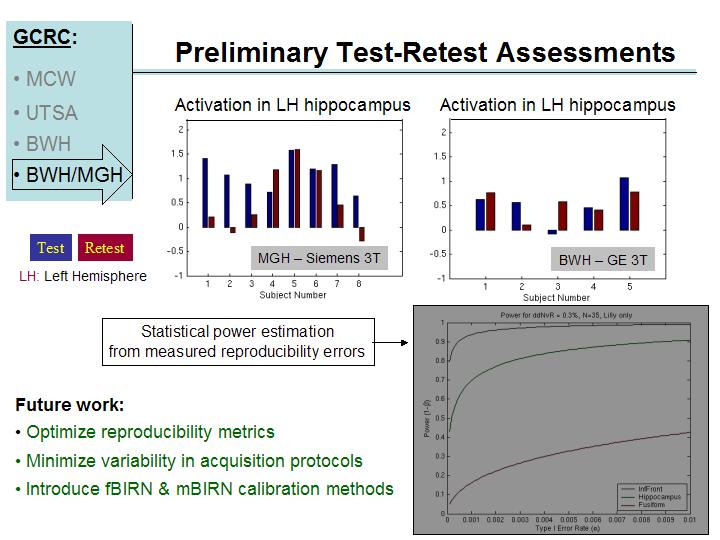Updates-5
From NAMIC Wiki
Home < Updates-5
GOAL REMINDER
- Optimize reproducibility of functional MRI for use in longitudinal clinical trials, with the goal of enabling MRI to robustly detect changes earlier and with less subjects as needed by traditional behavioural studies.
- Combine expertise from mBIRN & fBIRN to further validate and optimize multi-site acquistion protocols and also to explore metrics that quantify test-retest reproducibility
- Deliverables:
- Recommendations for a) multi-site longitudinal fMRI acquisition protocol and b) quantification methods for estimating test-retest reproducibility and it's use for longitudinal experimental design
- Validation (data analysis) supporting the above recommendations
UPDATES
April 26, 2005 (J. Jovicich)
- Preliminary analyses on reproducibility of functional activation: the main activation areas detected by the block-designed associative memory task (face-name pairs) are: hippocampus, inferior frontal, fusiform.
- The analysis is still in progress. Below are sample results:
- Reproducibility: sample reproducibility results of the left hippocampus activation area measured on several subjects at the MGH and BWH sites. There is significant variability, across and within sites. We are investigating possible sources of this, including image noise variability across the scanners and the pulse sequence variability.
February 20, 2005 (J. Jovicich)
- DATA ACQUISITION
- Sites
- MGH (3T Trio Siemens)
- BWH (3T GE)
- Phantom Data
- fBIRN Agar phantom
- Goal: compare image noise differences, pulse sequence differences, T2* effects across the two sites
- EPI Sequences – TE = 30, 35, 40, 45 ms
- Average T2* were comparable: 42.03 ms (GE) and 42.22 ms (Siemens)
- There seem to be significant noise differences that are being investigated
- We are also looking at the details of the pulse sequence differences
- Human Data
- MGH (3T Siemens): 13 subjects, 8 scanned twice and 5 scanned 3 times
- BWH (3T GE): 10 Alzheimer subjects, each scanned 3 times, and some will be scanned a 4th time.
- Thus there are currently scans from 23 subjects for testing of reliability and validation. There are currently no cross-site subjects (i.e., subjects scanned at both sites).
- fMRI Task
- Associative memory paradigm: remember novel and repeated name-face pairs. Block design (40s novel, 25s fixation, 40s repeated, 25s fixation). Constrast of interest: activation during novel vs repeated blocks.
- Sites
